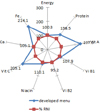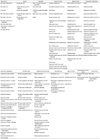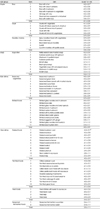Abstract
Objectives
This study developed two weeks menu using temple foods, assessed preference for the menu among ordinary people, and determined the possibility of using temple foods to make out institutional food service menu.
Methods
To make out the menu, 153 typical types of temple food were selected, under several conditions, thus including balanced food groups, natural foods in season, preparation time, preparation methods, and foods appropriated for institutional foodservice.
Results
Developed menu contained 1905.8 kcal, had low fat content, high dietary fiber, vitamin, and mineral content, and good protein content in the nutritional respect, and fit protein requirements with low calorie content and high nutritional value. In the assessment of the food preference for 73 temple food items, most of the foods scored high (4 out of 5 points) for preference in general; therefore, the menu tended to be satisfied to the adults' preference. In particular, boiled rice (rice with chwi, rice with cirsium, rice with mushroom, rice with mushroom & vegetable and gimbap with tofu) and fried foods (fried shiitake with sweet & sour sauce and fried kelp) were highly preferred.
Conclusions
The menu using temple foods can be a healthy choice for adults if it is well planned and managed. This study may be expected to provide basic data that would help developing menu to popularize temple foods. The above results could be applied at home as well as at foodservice institutes and furthermore could offer information for developing temple food products.
References
1. Kim MH, Bae YJ, Lee DH, Cho HK, Choi SH, Sung CJ. A evaluation study on nutrient intake status and diet quality of middle and old aged vegetarian women in Korea. Korean J Community Nutr. 2005; 10(6):869–879.
2. Jang BJ. A study on the wellness, life satisfaction, subjective happiness, quality of life of the customer of healing food temple food : focused on physical·spiritual wellness. Northeast Asia Tour Res. 2013; 9(3):21–43.
3. Kim JA, Lee SY. Evaluation of served menu and management of foodservice in Korean buddhist temples. J East Asian Soc Diet Life. 2005; 16(2):215–225.
4. Lee SY, Kim JA. A study on temple food intake and health. J East Asian Soc Diet Life. 2014; 24(6):691–699.
5. Korea Rural Economic Institute. 2008 Rural prospect. 1st ed. Seoul: 2008. p. 131–154.
6. Choi JH. Global food consumption and production trends change. In : Proceedings of 2014 Annual Conference of The East Asian Society of Dietary Life; 2014 Nov 14; Seoul. p. 49–64.
7. Park JH. Study on the effect of Korean restaurants selected property customer satisfaction and revisit. In : Proceedings of 2010 Spring Symposium of The Korean Academic Association of Business Administration; 2010 Apr 16; Seoul. p. 1–16.
8. Stein K. Keeping up with a continuing trend in foodservice. J Am Diet Assoc. 2004; 104(9):1343–1344.
9. Kwon S, Lee S, Lee Y, Yoon J. Characteristics and current status of well-being menus served in contract-managed workplace foodservice. J Korean Diet Assoc. 2010; 16(1):1–12.
10. Lee KE, Hong WS, Kim MH. Students' food preferences on vegetarian menus served at middle and high schools. J Korean Diet Assoc. 2005; 11(3):320–330.
11. Kim HH, Kim YN. A preference analysis of vegetable group foods in primary school students and their mothers. J Korean Home Econ Educ Assoc. 2012; 24(3):73–88.
12. Hong JH, Cho MS. Acceptance of vegetable menus of a school lunch program by high school students in Seoul and its association with health and dietary behavioral factors. Korean J Food Sci Technol. 2012; 44(1):121–134.
13. Ahn SW, Choi MK. Characteristics of school menus from the Daegu and Gyeongbuk area. J Korean Soc Food Sci Nutr. 2013; 42(6):983–990.
14. Lee YK, Kim YN. The differences in preference for vegetables among primary school to university students in Gyeongbuk area. Korean J Community Nutr. 2014; 19(5):415–424.
15. Kang KK. A study on the current availability and popularization of the Korean buddhist temple dish [master's thesis]. Chodang University;2010.
16. Lee IS, Lee S, Ahn BM, Kim HS. Students awareness of temple food inspectors. In : Proceedings of 2010 Annual Conference of the Korean Society of Food and Cookery Science; 2010; Seoul. p. 130.
17. Lee NH. A study of influence on establishment a temple foods business by its characteristics [master's thesis]. Hoseo University;2012.
18. Moon HK, Chung HR, Cho EY. Analysis of menu patterns from the Korean national nutrition survey in 1990. Korean J Diet Cult. 1994; 9(3):241–250.
19. Lee SY. Tradition temple food recipe standardization. Korean Buddhism corporation;2013. Report No. 010110-01-2013-081.
20. Lee SY. A study on temple food intake and health. Korean Buddhism corporation;2014. Report No. 010110-14-2014-030.
21. The Korean Nutrition Society. Dietary reference intakes for Koreans. 1st revision. Seoul: 2010. p. 9.
22. The Korean Nutrition Society. CAN-Pro [CD-ROM]. Version 4.0. Seoul: The Korean Nutrition Society;2011.
23. Krebs-Smith SM, Smiciklas-Wright H, Guthrie HA, Krebs-Smith J. The effects of variety in food choices on dietary quality. J Am Diet Assoc. 1987; 87(7):897–903.
24. Kant AK, Schatzkin A, Block G, Ziegler RG, Nestle M. Food group intake patterns and associated nutrient profiles of the US population. J Am Diet Assoc. 1991; 91(12):1532–1537.
25. Kim DJ. Nengumkyung. 1st revision. Seoul: Minjoksa;2005. p. 268.
26. Lee YM. Mahasungkiyul. 1st revision. Seoul: The institute of tripitaka Koreana;2010. p. 337.
27. Seo HK. Food culture of buddhism. Asian Comp Folk. 2003; 24(2):197–226.
28. Son SH, Lee HJ, Park K, Ha TY, Seo JS. Nutritional evaluation and its relation to the risk of metabolic syndrome according to the consumption of cooked rice and cooked rice with multigrains in Korean adults: based on 2007-2008 Korean National Health and Nutrition Examination Survey. Korean J Community Nutr. 2013; 18(1):77–87.
29. Kim MH. The assessment of the vegetarian menus and the school foodservice quality [master's thesis]. Dongduk Women's University;2004.
30. Lee Y, Kim M, Chong HK, Kim HR, Shim JE, Cho H, et al. Evaluation of traditional aspects of school lunch menus in Korea by analyzing dish group composition. Korean J Community Nutr. 2013; 18(4):386–401.




 PDF
PDF ePub
ePub Citation
Citation Print
Print









 XML Download
XML Download